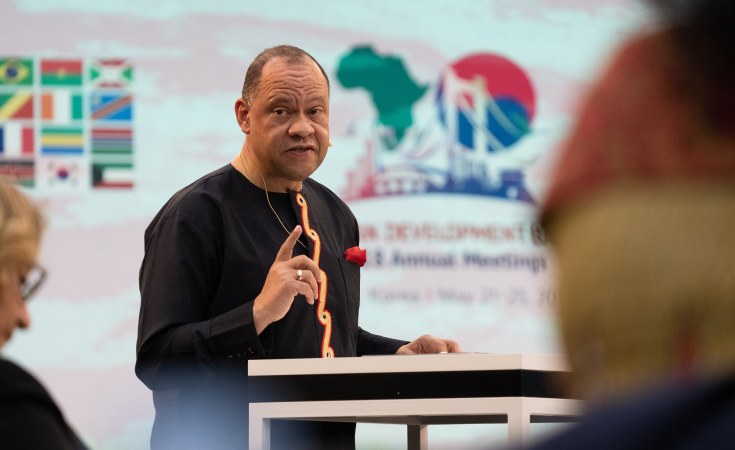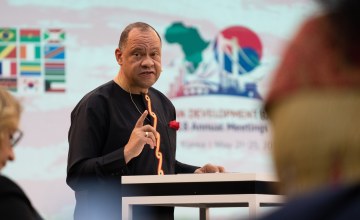The mandate of the African Development Bank is to work for Africa's development. But what is the tangible impact of its operations in the field and on the daily lives of millions of Africans? A conversation with Simon Mizrahi, Director of the Bank’s Service Delivery, Performance Management and Results.
Africa’s development priorities come with many challenges. How do the Sustainable Development Goals connect with the Bank’s High 5s to find solutions to them?
The SDGs are important because they sharpen our focus, direct our attention, and help mobilize resources to get things done.
Today, the international community must focus its attention on Africa. By 2030, 9 out of every 10 low-income countries will be in Africa. So, put simply, without Africa the world will not achieve the SDGs.
The good news is that Africa’s transformation out of poverty can be achieved in a generation. But it will require major investments in areas that are critical to Africa’s economic transformation.
This is why the Bank is focusing its attention on five priority areas that we call the High 5s: Light up and power Africa; Feed Africa; Industrialize Africa; Integrate Africa, and Improve the quality of life for the people of Africa. All of these are critical to the SDGs. According to the United Nations, delivering on the Bank’s High 5s will achieve up to 90% of the SDGs.
The continent’s needs are substantial and constantly growing. What has the Bank done? How has it positioned itself over the past few years to serve these needs?
Yes, Africa’s needs are indeed substantial. We estimate that achieving the High 5s alone will require about US $170 billion annually.
Since 2010, we have doubled the size of our lending. And we have increased our contribution to low-income countries and fragile states seventeenfold.
We are maximizing the use of our capital so that every dollar on our balance sheet achieves much more for Africa’s development.
We have increased our net operating income, which shot up to US $781 million in 2017. Of that amount, 90% goes to support our work low-income countries.
That being said, at the end of the day, the scale of Africa’s needs will always significantly outstrip the financial capacities of any single institution. The Bank cannot afford to work in isolation.
This is why we are increasingly working with other to crowd in public and private resources through co-financing. In South Africa, for example, we mobilized nearly US $1 billion in support of a large electricity company.
And even more importantly, we are working to help governments raise their domestic resources through more effective taxation so that they can meet their own development needs without having to turn to the Bank.
What has the Bank been doing on industrialization and how effective have you been in that regard?
The foundation for sustainable development in Africa has to be industrialization. Africa will not achieve the Sustainable Development Goals simply by exporting raw materials. It needs to move up global value chains, adding value to all its production to generate jobs and prosperity for Africans.
Take the case of Ethiopia, a country that is now becoming a competitive global exporter in textiles and footwear. Since 2004, manufacturing value-added increased by more than 10% a year, making it one of Africa’s fastest-growing world economies.
This is why the Bank, as part of its Industrialize Africa strategy, is supporting African businesses in international value chains and helping governments develop industrial policies and strengthen their business environments.
One example of how the Bank is doing this is through its support to Ethiopia’s Derba Midroc Cement Plant, which has reduced the price of cement by 70%.
The 2018 Annual Development Effectiveness Review is a comprehensive assessment of the effectiveness of the Bank’s development interventions. It was released at the Bank’s Annual Meetings. What does it tell us about the Bank’s impact?
Every organization needs a yardstick to measure its success. At the African Development Bank, we use our development impact as a yardstick; in fact it is our bottom line. Over the years, our understanding has deepened of what it takes to deliver this bottom line.
We understand that inclusive growth is an essential part of the process; that it supplies households with livelihoods and governments with the means to invest in public goods and services. We also understand that development is about empowering people to achieve their needs and aspirations, including through education and better health.
Understanding development is one thing, but measuring it is very different.
We call that tool that we use to measure development impact the Annual Development Effectiveness Review. It is a publication that brings together the evidence of our strengths and weaknesses and helps us understand what we are doing well and what we need to do better to achieve our development goals.
Development is clearly one of the most challenging businesses in the world. Not everything works as planned. But by constantly scrutinizing our performance, we make sure we are always moving in the right direction.
The Bank cannot be an effective development organization without a deep understanding of Africa’s development trends. For this reason, we focus our attention each year on an important development theme. In this year’s edition we chose to focus on Africa’s industrialization, the theme this year’s Annual Meetings.
Focusing on the Bank’s own performance, what does this year’s ADER tells us?
Each year, the ADER examines the Bank’s operational effectiveness and its organizational efficiency. This is a management tool that helps us assess our performance against the targets and milestones we set ourselves. The ADER provides a very candid assessment of what has worked well and what has worked less well.
In 2017, what we see is that the Bank’s overall performance improved. Our operations were more successful in achieving their development outcomes. The quality of the Bank’s portfolio improved as did organizational efficiency.
By bringing together evidence of our strengths and weaknesses, the Annual Development Effectiveness Review gives us a tool for identifying where we can strengthen our efforts to improve the lives and livelihoods of Africans and supports our commitment to transparency and accountability to our member countries, our stakeholders, and our partners.



